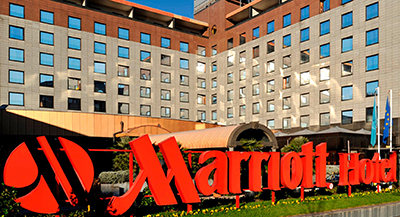Marriott hit the reset button on its media strategy last year as the COVID-19 pandemic brought the travel industry to a halt and forced the world’s largest hotel company to find dynamic ways to reach a new type of traveler.
Marriott International saw its occupancy demand – and revenue per available room – plummet 90% at the height of the pandemic last April.
Andy Kauffman, Marriott’s senior vice president of marketing channels and optimization, described the impact of the pandemic on the company’s business as greater than the effects of 9/11 and the Great Recession combined. The company reported a net income of $100 million in Q3 2020, compared to $387 million in Q3 2019.
“As we started to re-engage our recovery plan, we actually activated a number of new marketing strategies and … looked at who we worked with and how we could deepen some of our existing partnerships,” he said. “We looked for partners that could engage the new traveler as travel behavior changed … and target across mobile, social, digital, and that could enable us to measure the effects that our efforts had in really driving business in an agile way.”
Like other advertisers, Marriott had to rethink how it spent its marketing dollars during a prolonged shutdown and business travel plunge. Later, as some markets saw gradual re-openings, travelers – mainly drivers – looked to stay closer to home.
Although Marriott paused its media efforts across 30 brands around the world at the height of the pandemic last year, by April it was formulating a recovery plan and streamlining operations. It quickly pivoted its media strategy to be more agile and data-driven around its 7,500 properties spanning 132 countries.
“We really wanted to bring the entire portfolio together for consumers as an opportunity to showcase our 30 brands, our homes and villas products, and some of the new offerings that we rolled out such as work from anywhere,” Kauffman said. “The idea of showcasing that portfolio, given that we have a brand or offering for anyone’s travel needs, has resulted in far better results than an individual brand-by brand-effort.”
The company partnered with Verizon Media to develop a “Browse, Shop and Buy” marketing strategy, a predominantly mobile campaign that helped Marriott secure tens of thousands of bookings since it launched in June.
The goal was to find consumers who were traveling and get them to book Marriott properties. This approach revealed a new-at-the-time segment of travelers: people who were taking local or regional road trips.
A big part of the campaign, which is ongoing, was emphasizing the company’s commitment to cleanliness and sanitization, and promote local travel to reach individuals “who wanted spaces where they could spread out – and for longer periods of time,” Kauffman said.
“The data told us you need local travel, you need to promote certain spaces and you need to reinforce the cleanliness commitment,” Kauffman said. “And what you promote to people who live in Seattle is going to be different than what you promote to people that live in New York City, obviously if they’re driving.”
Working with Verizon Media, Marriott developed an interactive mobile Drive Trip Recommendation tool that served personalized destination recommendations – hotels or rental homes Marriott offers in certain locations – to users based on how far they wanted to drive. Destination content was tailored in real-time based on in-unit engagement from audiences in 30 major US cities.
The experience, Kauffman said, far exceeded benchmarks for the campaign – clickthrough rates (CTR) were 4.5 times greater than benchmarks for mobile interactive ad units. The mobile app was Marriott’s top performer, with an unprecedented CTR of 4.78%.
Clickthrough rates to Marriott.com was 12% – double Verizon’s benchmark of 6% – and drove significant incremental traffic to the site, compelling travelers to book their travel with Marriott Bonvoy, Marriot’s combined loyalty program that includes Marriott Rewards, Ritz-Carlton Rewards and Starwood Preferred Guest with over 145 million members.
Kauffman declined to share occupancy rates related to the campaign, but said that Marriott’s ROI “was actually at par with what we had previously done pre-COVID.”
According to Magna’s Global Advertising Forecast released in December, the auto and travel industries will remain financially fragile in 2021 as high unemployment rates lead to fewer people making large purchase decisions and the lingering effects of the pandemic will lead to fewer people traveling. And even if there is a recovery, the sector will remain cautious with marketing costs and lean toward direct media rather than linear media.
Kauffman said there has been a gradual recovery since April, with some markets recovering faster than others. And with the rollout of vaccines, Kauffman said there is more optimism in 2021.
“We believe as we look forward there is a tremendous amount of pent up demand … to travel and we’re starting to see people taking action,” he said. “And that’s evidenced by booking windows starting to expand – the time from booking to travel. We’re seeing that grow as people are certainly planning more for the future.”
Further reading on the travel and tourism sector: How Wyndham Hotels dealt with the pandemic.















